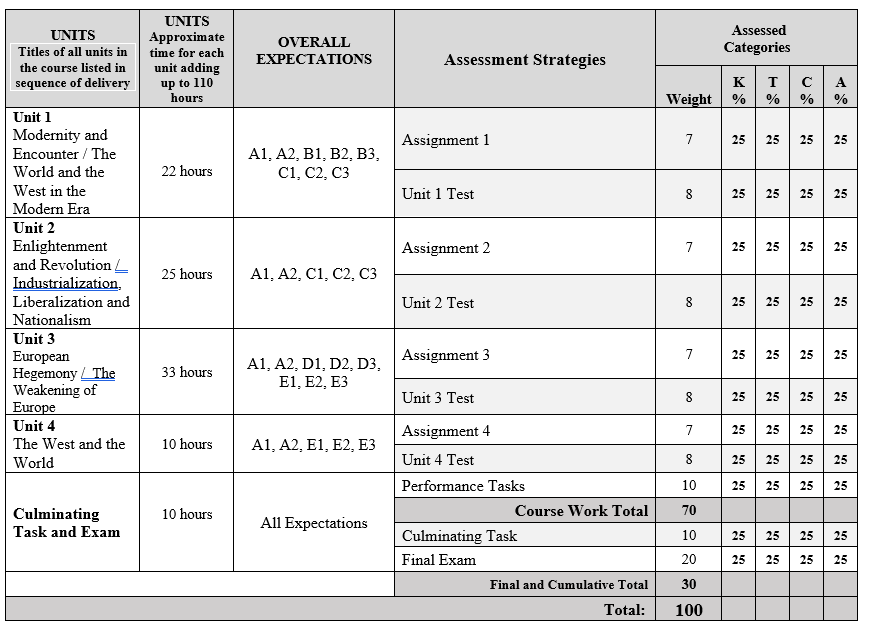Course Description
This course traces major developments and events in world history since approximately 1450. Students will explore social, economic, and political changes, the historical roots of contemporary issues, and the role of conflict and cooperation in global interrelationships. They will extend their ability to apply the concepts of historical thinking and the historical inquiry process, including the interpretation and analysis of evidence, as they investigate key issues and ideas and assess societal progress or decline in world history.
Course Code: CHY4U
Course Name: World History since the Fifteenth Century
Department: Canadian and World Studies
Hours: 110
Credit Value: 1.0
Pre-requisites: Any university or university/college preparation course in Canadian and world studies, English, or social sciences and humanities.
Curriculum Policy Documents: The Ontario Curriculum, Grades 11 & 12. Canadian and World Studies, 2015 (Revised)
Growing Success: Assessment, Evaluation, and Reporting in Ontario School. 2010.
Development Date: August 2019
Developed By: Jimmy Chia
Overall Curriculum Expectations
Unit Description
| Unit | Unit Title | Approx. Duration |
| Unit 1 | Modernity and Encounter, 1420-1492 | 17 |
| The World and the West in the Modern Era, 1492-1750 | 15 | |
| Unit 2 | Enlightenment and Revolution, 1680-1840 | 13 |
| Industrialization, Liberalization and Nationalism, 1815-1871 | 12 | |
| Unit 3 | European Hegemony, 1871-1914 | 15 |
| The Weakening of Europe, 1914-1945 | 18 | |
| Unit 4 | The West and the World, from 1945 | 10 |
| Culminating Task and Exam | 10 | |
| TOTAL | 110 hours | |
Unit Description
Teaching/Learning Strategies
- Research project
- Independent study
- Oral Presentations
- Debate
- Case summary
- Presentation
- Graphic Organizers
- Computer-Mediated Instruction
- Lectures
- Discussions
- Reading
- Pair Work
- Role Play
- Brainstorming
- Group work
Unit Organization

Assessment Strategies
| For Learning | As Learning | Of Learning |
|
|
|
Evaluation Strategies
Evaluation focuses on student’s achievement of the overall Expectations. Evaluation is basically collected from; observations, conversations, and student products.
Student Products include: tests, exams, rich performance tasks, projects, presentations and /or essays. Students submitting assignments that involved group work will be evaluated individually.
Before making a decision about a student’s final grade, the teacher will consider all the collected evidence of student products. The teacher will also consider that some evidence carries more weight than other evidence.
| Achievement Level | Percentage Mark Range |
| 4+ | 95-100 |
| 4 | 87-94 |
| 4- | 80-86 |
| 3+ | 77-79 |
| 3 | 73-76 |
| 3- | 70-72 |
| Achievement Level | Percentage Mark Range |
| 2+ | 67-69 |
| 2 | 63-66 |
| 2- | 60-62 |
| 1+ | 57-59 |
| 1 | 53-56 |
| 1- | 50-52 |
The final grade will be determines as follows:
- 70% Seventy percent of the grade will be based on evaluation conducted throughout the course.
- 30% Thirty per cent of the grade will be based on a final evaluation and the summative administered at or towards the end of the course.
Evaluation/Assessment Plan
| Unit | Unit Title | Approx. Duration | KICA % Application |
| Unit 1 | Modernity and Encounter / The World and the West in the Modern Era | 22 hours | 25/25/25/25 |
| Unit 2 | Enlightenment and Revolution / Industrialization, Liberalization and Nationalism | 25 hours | 25/25/25/25 |
| Unit 3 | European Hegemony / The Weakening of Europe | 33 hours | 25/25/25/25 |
| Unit 4 | The West and the World / Review / Exam | 20 hours | 25/25/25/25 |
| TOTAL | 110 hours | ||
Resources
Haberman, A. and Adrian Shubert. (2002). The West and the World: Contacts, Conflicts, Connections. Toronto: Gage Learning.
